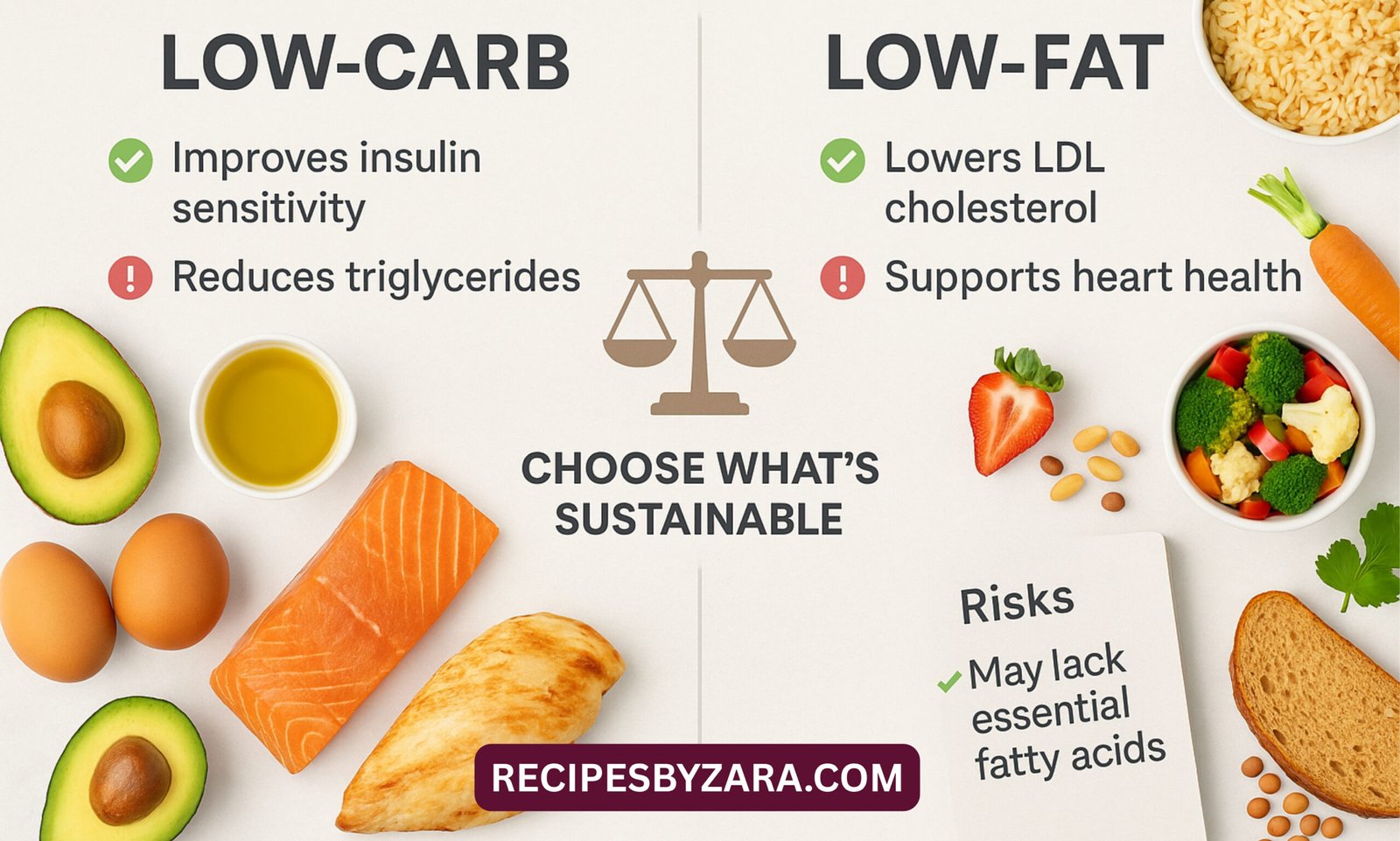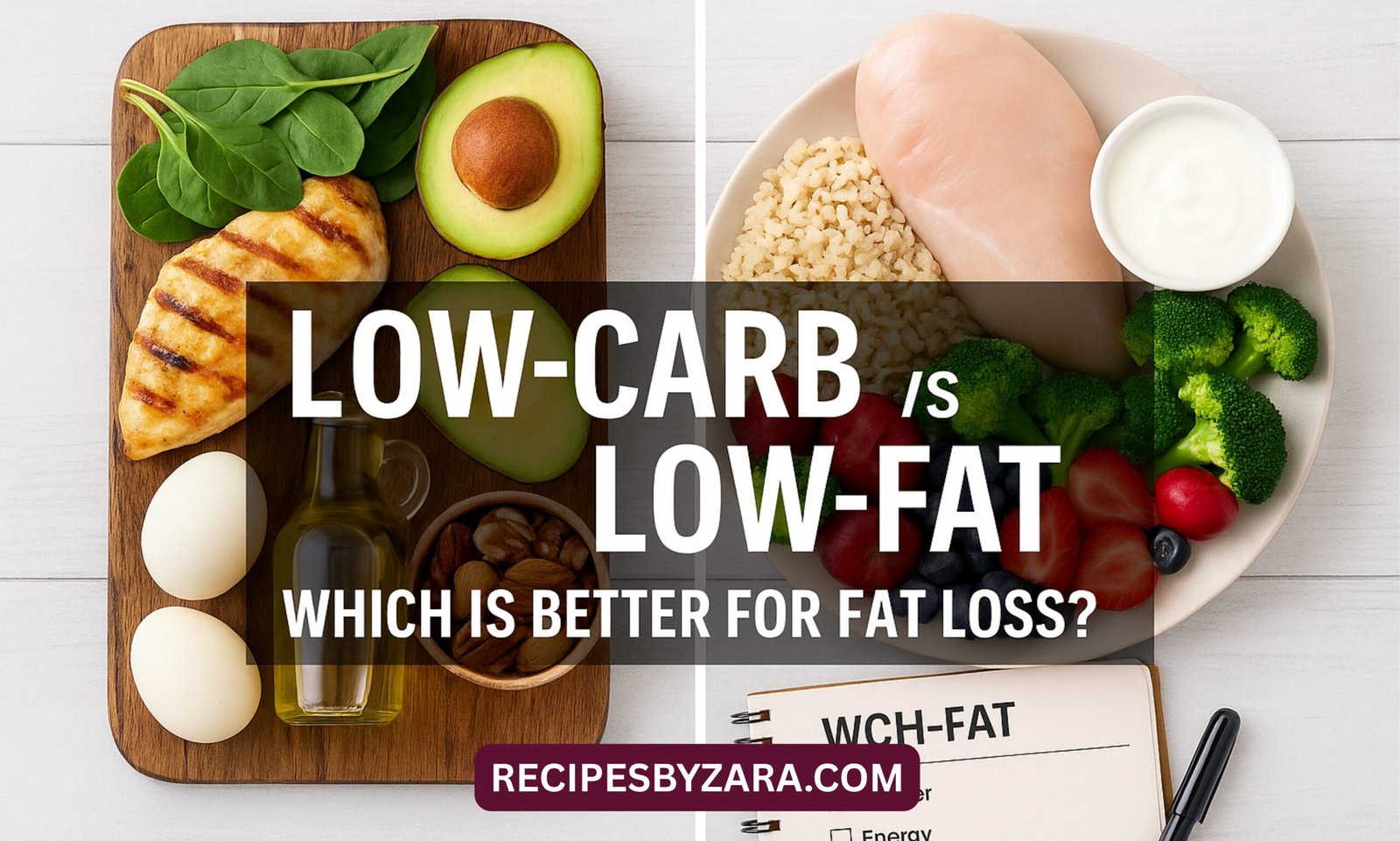Low Carb vs Low Fat: Which Works Better for Fat Loss?
Struggling to choose between a low-carb vs low-fat diet? This comprehensive guide compares both for fat loss, analyzing effectiveness, energy levels, and long-term success.
Choosing the right diet for fat loss can be overwhelming. Two of the most popular and widely debated options are low-carb and low-fat diets. Both claim to help people shed pounds and improve health, but the question remains: which one really works better?
For decades, low-fat diets were the go-to method, especially in the 1980s and 1990s, promoted as heart-healthy and ideal for weight management. However, the rise of low-carb diets, especially keto, has shifted the narrative. People now argue that cutting carbs leads to faster fat loss and better appetite control.
This article dives deep into the science, benefits, challenges, and real-life results of each approach. By the end, you’ll have a clear understanding of low-carb vs low-fat diets and which one may suit your personal fat loss journey best.
1. Low-Carb Diets

A low-carb diet significantly reduces carbohydrate intake, typically focusing on increasing protein and fat consumption instead. Carbohydrates usually make up a large percentage of most people’s diets, but low-carb diets slash this number, often limiting carbs to 20–100 grams per day.
Common low-carb foods include meats, eggs, non-starchy vegetables, healthy fats like avocado and olive oil, and sometimes full-fat dairy. The goal is to force the body to burn fat for fuel instead of glucose, triggering a state known as ketosis in more restrictive versions like keto.
This dietary shift alters the body’s metabolism. Without a steady stream of carbs, insulin levels drop, and fat stores become the body’s primary fuel source. This process often leads to faster initial weight loss due to water weight reduction and enhanced fat burning.
Additionally, the high-fat low-carb diet often leads to better satiety. Protein and fat are more filling than carbohydrates, which may reduce overall calorie intake. Many people report decreased cravings, improved energy, and better compliance with their meal plans.
2. What Is a Low-Fat Diet?

In contrast, a low-fat diet limits the amount of dietary fat you consume, generally aiming to keep fat intake below 30% of daily calories. The focus shifts to complex carbs, lean proteins, and high-fiber foods like whole grains, fruits, and vegetables.
Popular during the late 20th century, the low-fat diet gained traction due to studies linking dietary fat with heart disease. This led to a surge in low-fat recipes, fat-free products, and carb-heavy meals labeled as “healthy.”
A low-fat food list typically includes items like oatmeal, brown rice, legumes, skinless poultry, and plenty of vegetables. It discourages butter, full-fat dairy, red meat, and anything fried. The goal is to reduce calorie density, control cholesterol, and create a daily calorie deficit for weight loss.
While low-fat diets may not trigger rapid fat burning like their low-carb counterparts, they are supported by plenty of long-term studies. When paired with portion control and regular physical activity, a low-fat meal idea approach can produce steady fat loss without major dietary restrictions.
3. Comparing Fat Loss Results: What Does Science Say?

The battle of low-carb vs low-fat has been closely studied over the past two decades. Research shows that both approaches can be effective for fat loss, but results vary depending on the individual, their metabolism, and how well they stick to the diet.
A well-known study published in The New England Journal of Medicine compared low-fat and low-carb diets over 12 months. It found that the low-carb group lost slightly more weight initially, especially in the first 3–6 months. This was attributed to better appetite suppression and quicker water loss.
However, after a year, the difference in fat loss between the two groups often diminished. Body composition changes were similar, with both groups losing fat and some muscle, depending on their protein intake and activity levels. This supports the theory that the best diet is the one you can stick to.
Another consideration is metabolic adaptation. People on low-carb diets often experience better insulin sensitivity, especially those with prediabetes or metabolic syndrome. On the other hand, low-fat diets tend to improve cholesterol levels more predictably in the general population.
Ultimately, scientific data supports both methods. Whether you choose keto vs low-fat, what matters more is your ability to stay consistent, meet your macronutrient tracking goals, and maintain a calorie deficit over time.
4. Hunger, Energy, and Satisfaction: Which Diet Wins?

When it comes to hunger control and satisfaction, many people prefer low-carb diets. The increased protein and fat content tends to be more satiating, leading to fewer hunger pangs and reduced snacking. This makes it easier to stick with a calorie-controlled fat loss meal plan.
Low-carb snacks like cheese, nuts, and hard-boiled eggs help maintain stable energy levels and reduce cravings. Additionally, low-carb approaches avoid the blood sugar spikes and crashes often associated with carb-heavy meals. This leads to more stable energy and focus throughout the day.
In contrast, low-fat diets can leave some people feeling hungry if not properly balanced. Meals that are low in both fat and protein may lack satiety, making it harder to sustain. However, by emphasizing high-fiber carbs like oats, quinoa, and legumes, some people experience steady hunger control.
Energy-wise, it varies per person. Some thrive on the clean-burning energy of low-fat meal ideas, while others feel sluggish without fats. Ultimately, both approaches can be satisfying if designed correctly using real, whole foods, and adjusted based on individual response.
When choosing between low-carb vs low-fat, it’s important to evaluate your mood, energy, and hunger levels after meals. That will give you the most honest answer about which approach aligns with your body’s needs.
5. Health Benefits and Risks of Each Approach

Both low-carb and low-fat diets offer unique health benefits when done properly. A low-carb diet is particularly effective in reducing blood sugar, improving insulin sensitivity, and aiding in fat burning for people with diabetes, PCOS, or metabolic resistance.
Studies show that low-carb vs low-fat diets can both lower cholesterol, but they affect lipid panels differently. Low-fat diets tend to reduce LDL cholesterol more, while low-carb diets can raise HDL (the “good” cholesterol) and lower triglycerides.
However, there are risks to both. Overdoing fat on low-carb planespecially saturated fatsmay raise LDL levels for some individuals. On the flip side, too little fat on a low-fat diet can lead to deficiencies in essential fatty acids and fat-soluble vitamins (A, D, E, K).
Compliance is also a major health factor. A diet you can’t stick to may lead to yo-yo weight cycling, which is worse for health than being moderately overweight. Choose the plan that supports your lifestyle diet choices and encourages sustainable behavior rather than short-term extremes.
6. Which Diet Is Right for You?

So, in the great debate of low-carb vs low-fat, which diet should you choose for fat loss? The honest answer is: it depends.
If you enjoy rich, savory meals and don’t mind skipping bread or pasta, you may thrive on a high-fat low-carb diet. It’s a great fit for those with insulin resistance or anyone looking to control cravings and stabilize energy throughout the day.
On the other hand, if you prefer fruits, legumes, and grains and want to minimize dietary fat intake for heart health a low-fat diet might be more aligned with your lifestyle. Many athletes and vegetarians find this approach easier to follow.
Consider experimenting for a few weeks. Try each approach while maintaining similar calorie intake and monitor changes in body composition, energy, sleep, and hunger. This is where tracking macros, even loosely, becomes a valuable tool.
What matters most is sustainability. Whichever plan fits into your life without stress or sacrifice is likely to be your best option not just for fat loss, but for long-term health.
Conclusion
The low-carb vs low-fat debate has been around for decades and it’s clear there’s no universal winner. Both dietary approaches offer powerful tools for fat loss, appetite control, and improved health when done correctly.
Low-carb diets may offer faster short-term results and better blood sugar control, while low-fat diets tend to be more familiar, less restrictive, and easier to follow for some people. Each has pros and cons, and the best diet is the one that fits your lifestyle and keeps you consistent.
Instead of getting stuck in labels or diet trends, focus on real food, proper portions, and a calorie intake that aligns with your goals. In the end, fat loss comes down to consistency, awareness, and creating a routine that works for you or against you.
FAQs
Q1: Can I combine low-fat and low-carb approaches for better results?
Yes, some people follow a balanced, moderate approach that limits both carbs and fats while emphasizing protein and whole foods. This method avoids extremes and focuses on sustainability. Just make sure your total calories still support a deficit if fat loss is your goal.
Q2: Which diet gives faster results for fat loss: low-carb or low-fat?
Low-carb diets often produce faster short-term results due to water weight loss and reduced appetite. However, long-term fat loss is similar when calorie intake is matched. The key is choosing the plan you can stick to consistently.
Q3: Is one better for women or men specifically?
No specific gender-based advantage exists. However, hormonal factors (like PCOS in women) may respond better to low-carb diets. The best choice depends on individual preferences, lifestyle, and health goals, not gender alone.
Q4: Do I need to count calories on either diet?
You don’t have to, but being calorie-aware helps. Even low-carb or low-fat foods can be overeating. Whether you track calories or use macronutrient tracking, ensuring you’re in a calorie deficit is key for fat loss success.
Q5: Can I follow these diets long-term safely?
Yes if they’re balanced and include nutrient-rich, whole foods. Avoid highly processed “diet” foods. Both low-fat and low-carb diets can be part of a healthy lifestyle if they meet your nutritional needs and are sustainable over time.






